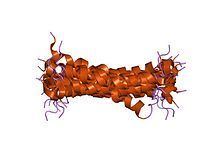Species Human Entrez 341 | Human Mouse Ensembl ENSG00000130208 | |
 | ||
Aliases APOC1, Apo-CI, ApoC-I, apo-CIB, apoC-IB, apolipoprotein C1, Apolipoprotein C-I External IDs OMIM: 107710 HomoloGene: 136749 GeneCards: APOC1 | ||
Apolipoprotein C-I is a protein component of lipoproteins that in humans is encoded by the APOC1 gene.
Contents
Function
The protein encoded by this gene is a member of the apolipoprotein C family. This gene is expressed primarily in the liver, and it is activated when monocytes differentiate into macrophages. A pseudogene of this gene is located 4 kb downstream in the same orientation, on the same chromosome. This gene is mapped to chromosome 19, where it resides within an apolipoprotein gene cluster. Alternatively spliced transcript variants have been found for this gene, but the biological validity of some variants has not been determined.
Apolipoprotein C1 has a length of 57 amino acids normally found in plasma and responsible for the activation of esterified lecithin cholesterol with an important role in the exchange of esterified cholesterol between lipoproteins and in removal of cholesterol from tissues. Its main function is inhibition of CETP, probably by altering the electric charge of HDL molecules.
During fasting (like other apolipoprotein C), it is found primarily within HDL, while after a meal it is found on the surface of other lipoproteins. When proteins rich in triglycerides like chylomicrons and VLDL are broken down, this apoprotein is transferred again to HDL. It is one of the most positively charged proteins in the human body.
Interactive pathway map
Click on genes, proteins and metabolites below to link to respective articles.
